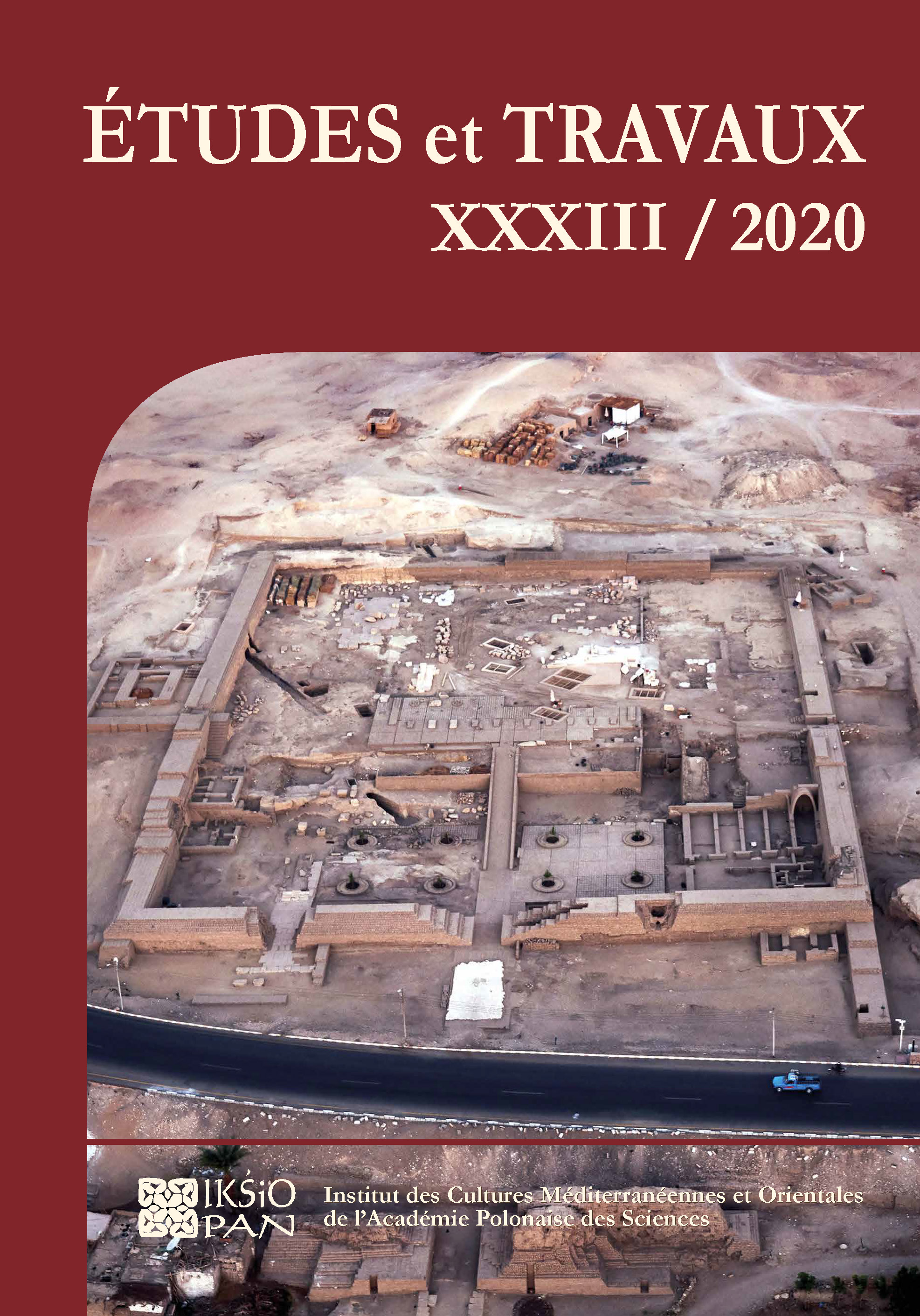Square Grids in the Tomb of Akhethotep – Questions and Doubts
DOI:
https://doi.org/10.12775/EtudTrav.33.010Słowa kluczowe
reliefs, human proportion in art, hypothetical square grid, guidelines, Akhethotep, Old Kingdom EgyptAbstrakt
The proportions of the human figure in Egyptian art were determined on the basis of simple and rarely changing rules. The oldest preserved guidelines used for this purpose come from the times of the Fifth Dynasty, and the square grids from the mid-Twelfth Dynasty. The objective of this article is to interpret the guidelines from the chapel of vizier Akhethotep, dated to the Fifth Dynasty, and answer the following questions: when were they made and what rules were used to determine the proportions of the vizier’s body? To do this, the author proposes employment of a measuring method which uses square grids as the main tool and the smallest element of the grid, that is, the square module as the basic measurement unit.
Bibliografia
Assmann, J. 1987: Hierotaxis. Textkonstitution und Bildkomposition in der altägyptischen Kunst und Literatur, [in:] Osing, J., Dreyer, G. (Eds), Form und Maß. Beiträge zur Literatur, Sprache und Kunst des alten Ägypten, ÄAT 12, Wiesbaden, 18–42
Bács, T. 2020: When Ancient Egyptians Copied Egyptian work, [in:] Davies, V., Laboury, D. (Eds), The Oxford Handbook of Egyptian Epigraphy and Palaeography, New York, 147–162
Brock, L.P., Shaw, R.L. 1997: The Royal Ontario Museum Epigraphic Project – Theban Tomb 89 Preliminary Report, JARCE 34, 167–177
Brunner-Traut, E. 1974: Epilogue: Aspective, [in:] Schäfer, H., Principals of Egyptian Art, Ed. Brunner-Traut, E., Baines, J., Oxford, 423–446
Brunner-Traut, E. 1990: Frühformen des Erkennens am Beispiel Altägyptens, Darmstadt
Chapelle de la tombe d’Akhethetep: www.louvre.fr/en/mediaimages/chapelle-de-la-tombed-akhethetep (accessed July 17, 2018)
Chapelle de la tombe d’Akhethetep 2: www.louvre.fr/en/mediaimages/chapelle-de-la-tombed-akhethetep-2 (accessed July 17, 2018)
Chapel tomb Akhethotep: https://www.louvre.fr/en/oeuvre-notices/chapel-tomb-akhethotep (accessed July 17, 2018)
Davies, N. de G. 1902: The Rock Tombs of Deir el Gebrâwi II, ASEg XII, London
Firth, C.M., Quibell, J.E. 1935: Excavations at Saqqara: The Step Pyramid, vol. 2: Plates, Cairo
Fisher, C.S. 1924: The Minor Cemetery at Giza, Philadelphia
Friedman, F.D. 1995: The Underground Relief Panels of King Djoser at the Step Pyramid Complex, JARCE 32, 1–42
Iversen, E. 1975: Canon and Proportion in Egyptian Art, Warminster
Iversen, E. 1976: The Proportions of the Face in Egyptian Art, SAK 4, 135–148
Kanawati, N. 2011: Art and Gridlines: The copying of Old Kingdom scenes in later periods, [in:] Bárta, M., Coppens, F., Krejči, J. (Eds), Abusir and Saqqara in the Year 2010, vol. 2, Prague, 483–496
Kuraszkiewicz, K.O. forthcoming: An unorthodox 6th Dynasty tomb at Saqqara – funerary chapel of Ikhy/Mery, Collection Orient & Méditerranée, Paris
Lashien, M. 2010: Artists’ Training in the Old and Middle Kingdoms, GöttMisz 224, 81–84
Mackay, E. 1917: Proportion Squares on Tomb Walls in the Theban Necropolis, JEA 4/2–3, 74–85
Morkot, R. 2003: Archaism and innovation in art from the New Kingdom to the Twentysixth Dynasty, [in:] Tait, J. (Ed.), ‘Never had the like occurred’: Egypt’s view of its past, London, 79–99
O’Neil, J.P. (Ed.) 1999: Egyptian Art in the Age of Pyramids, New York
Panofsky, E 1955: Meaning in the visual arts: papers in and on Art History, New York
Pomerantseva, N. 1991: The geometrical basis of the proportional canon in ancient Egyptian art, DiscEg 20, 45–70
Radtke, K. 2011: Iconography of the Pharaoh’s Face in the Eighteenth Dynasty Relief, EtudTrav XXIV, 159–183
Radtke, K. forthcoming: The iconography of the pharaoh’s face in the eighteenth dynasty relief – metric analysis, Travaux de l’Institut des Cultures Méditerranéennes et Orientales de l’Académie Polonaise des Sciences VIII, Warsaw
Robins, G. 1983: Natural and Canonical Proportions in Ancient Egyptians, GöttMisz 61, 17–25
Robins, G. 1984: Analysis of Facial Proportions in Egyptian Art, GöttMisz 79, 31–41
Robins, G. 1991: Composition and the Artist’s Squared Grid, JARCE 28, 41–54
Robins, G. 1994: Proportion and Style in Ancient Egyptian Art, Austin
Robins, G. 1995: Canonical proportions and metrology, DiscEg 32, 91–92
Robins, G. 2001: The use of the squared grid as a technical aid for artists in Eighteenth Dynasty Painted Theban Tombs, [in:] Davies, W.V. (Ed.), Colour and Painting in Ancient Egypt, London, 60–62
Russmann, E.R. (Ed.) 2001: Eternal Egypt: Masterworks of Ancient Art from The British Museum, London
Saleh, M. 1977: Three Old Kingdom Tombs at Thebes, ArchVer 14, Mainz a/Rhein
Saqqara: http://www2.culture.gouv.fr/culture/arcnat/saqqara/fr/chapelle/chapelle_dis/chapelle_dis2c.htm (accessed July 17, 2018)
Schäfer, H. 1919: Von ägyptischer Kunst, besonders der Zeichenkunst. Eine Einführung in die Betrachtung ägyptischer Kunstwerke, Leipzig
Schäfer, H. 1974: Principles of Egyptian Art, Ed. Brunner-Traut, E., Baines, J., Oxford
Skubiszewski, P. 1973: Pojęcia, kierunki i metody historii sztuki, Elementy metodologii, [in:] Skubiszewski, P. (Ed.), Wstęp do historii sztuki, vol. 1, Przedmiot – Metodologia – Zawód, Warszawa, 227–265
Smith, W.S. 1949: A History of Egyptian Sculpture and Painting in the Old Kingdom, London
Szymański, J. 2001: Nauki pomocnicze historii, Warszawa
Tefnin, R. 1983: Essai d’analyse formelle du visage royal égyptien : un relief de Touthmosis III aux Musées royaux d’Art et d’Histoire de Bruxelles, [in:] Meulenaere, H. de, Limme, L. (Eds), Artibus Aegypti: Studia in honorem Bernardi V. Bothmer a Collegis Amicis Discipulis Conscripta, Bruxelles, 153–177
Wild, H. 1953: Le Tombeau de Ti, Fasc. II : La chapelle (première partie), MIFAO 65/2, Le Caire
Ziegler, C. 1993: Le Mastaba d’Akhethétep. Une chapelle funéraire de l’Ancien Empire, Paris
Ziegler, C., Adam, J.-P., Andreu-Lanoë, G., Bridonneau, C., Étienne, M., Lecuyot, G., Rozières, M.-F. de 2007: Le Mastaba d’Akhethetep, Fouilles du Louvre à Saqqara 1, Louvain
Pobrania
Opublikowane
Jak cytować
Numer
Dział
Statystyki
Liczba wyświetleń i pobrań: 851
Liczba cytowań: 1



